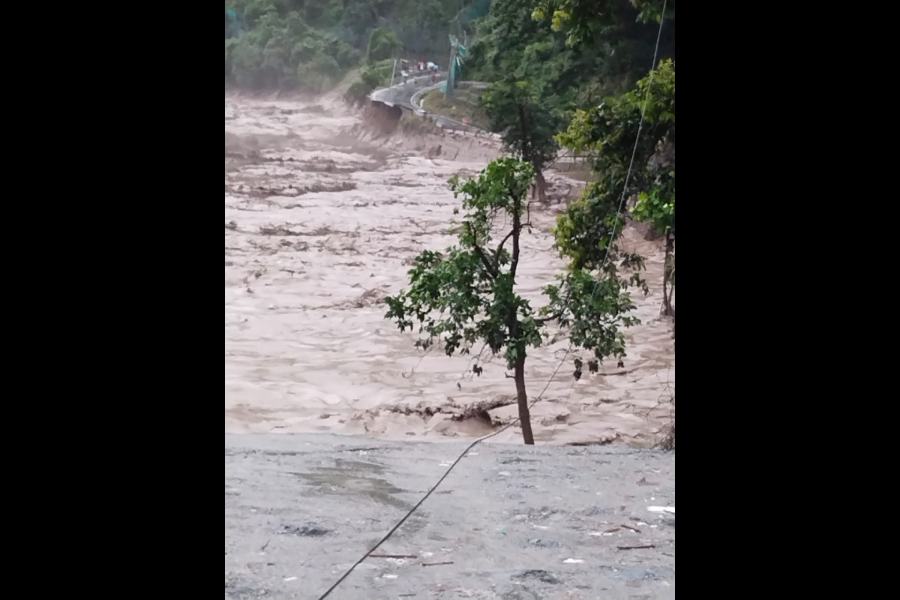On October 4, 2023, a flash flood, set off by an unexpected torrent, unleashed devastation in Sikkim’s Lachen Valley, resulting in a trail of destruction and sorrow in its wake. At least 10 Dead and 23 Army personnel have gone missing, and numerous civilians have been affected by the downpour.

Also Read: Nepal Hit by 2 Earthquakes, Strong Tremors Felt in North India
A downpour of water, rising to a stunning 15-20 feet in certain region, inundated the region, sweeping away everything in its path.
The flash flood had a devastating impact, washing away Army vehicles, submerging buildings, and causing widespread damage to infrastructure.
The Teesta River, which flows through Sikkim and West Bengal before entering Bangladesh, became a raging force, adding to the chaos.
The quick trigger for this catastrophe was a cloudburst over Lhonak Lake in North Sikkim. But, what is a cloudburst? It is a meteorological phenomenon characterized by a sudden and intense rainfall, often confined to a small area.
In this case, the small area was the region surrounding Lhonak Lake, which received an unprecedented downpour.
Adding to the intricacy of the circumstance, the flash flood can likewise be attributed to a Glacial Lake Outburst Flood (GLOF).
A GLOF occurs when a dam containing a glacial lake breaches, releasing a massive volume of water downstream. In this instance, the GLOF took place in Lhonak Lake, amplifying the already dire situation caused by the cloudburst.
Also Read: 4.2-Magnitude Earthquake Hits Italy’s Naples, Biggest Earthquake in 40 Years
The flash flood had disastrous results. Armed force staff positioned at Bardang near to Singtam bore the brunt of the disaster, with 23 soldiers reported missing, and their vehicles submerged in the slush.
Search and rescue operations were launched immediately, but the intermittent rain and thunderstorms in the region hampered these efforts.
Moreover, the flash flood disturbed fundamental transportation links. A portion of National Highway 10 (NH-10), which connects Sikkim with West Bengal, was washed away in the deluge. Bridges, roads, and infrastructure were severely damaged, cutting off vital routes and isolating regions.
The Indian Meteorological Department gave an alarm, cautioning residents of low-lying regions, including Gazoldoba, Domohani, Mekhaliganj, and Ghish, of the expected dangers.
The province of Sikkim was put under a high alert, with forecasts of heavy rainfall that could further exacerbate the flood situation.
As news about the calamity spread, political leaders at both the state and national levels swung into action. Sikkim’s Chief Minister, Prem Singh Tamang, personally visited the affected areas to assess the situation.
Also Read: Villarrica Volcano: Chile Raises Alert Level as Activity Increases
The Chief Minister likewise gave a full high alert, urging residents to stay away from the Teesta River. Additionally, schools in several districts were ordered to remain closed to ensure the safety of students.
Prime Minister Narendra Modi, deeply concerned about the calamity, assured the Chief Minister of Sikkim of all possible support.
In a tweet, he expressed his prayers for the safety and well-being of all those affected. The central government is actively coordinating efforts to assist the state in managing this crisis.
The outcome of the flash flood paints a grim picture. It has not only caused loss of life and property but also disrupted daily life for countless residents.
With roads washed away and bridges destroyed, transportation remains a significant challenge. Moreover, the isolation of regions like Gangtok due to the flooding further complicates the situation.
Sikkim’s weakness to such calamities is exacerbated by factors like melting glaciers due to climate change, unregulated construction in flood-prone areas, and the increasing frequency and severity of flash floods.
The state should now wrestle with the double difficulties of immediate relief efforts and long-term strategies to mitigate the impact of such events in the future.
Also Read: Rafflesia: The World’s Largest and Stinkiest Flower in Danger of Extinction
Top Sources Related to Sikkim Flash Floods: At Least 10 Dead and 23 Army Missing (For R&D)
Sources Related to Floods in Last 3 Months Around the World (For R&D)
- China floods: Xi Jinping urges action as rains kill 15 and displace thousands
- At Least 1 Dead as Heavy Rains Set Off Flash Flooding in New York
- Mongolia – Floods
- Assam Floods: About 18,000 People Suffer From Terrible Flood In Dhemaji District
- At least 50 dead in Pakistan monsoon floods since end of June
- New Delhi Floods: Deadly Monsoon Rains, leaving 15 Dead
- Japan Floods: Heavy Rains Causes Floods and Landslides, 1 Dead
- South Korea Floods: At Least 26 Dead and Over 1000 Evacuated
- Central Russia:10 Dead, Including 3 Children as Strong Winds hit Tourist Camp
- Typhoon Doksuri: Beijing’s Heaviest Rain in a Decade Kills at Least 11
- Slovenia Floods: At least 2 Dead, Forcing Evacuations
- Georgia: 11 Killed in Landslide at Mountain Resort Town of Shovi
- Alaska: Houses Swept Away by Glacial Floods in Juneau
- Nepal: At Least 38 Killed, Several Missing in Floods And Landslides
- China: 21 Killed, 6 Missing After Mudslide in Xi’an
- Hurricane Hilary hits California after Lashing Mexico
- Pakistan: Floods Force Evacuation of Almost 100,000 People
- Himachal Pradesh Landslide: 8 buildings Collapsed in Kullu
- Hurricane Idalia Makes Landfall in Florida and Georgia
- Typhoon Saola Threatens China with Category 4 Winds
- Typhoon Haikui: More than 4,000 People were Evacuated
- Brazil Cyclone Kills At Least 31 and Leaves Over 1,600 Homeless
- Dangerous Hurricane Lee Forecast to Become Category 5
- Hong Kong Flooded by Heaviest Rains in 140 Years
- Storm Daniel: At least 2,000 Dead and 10,000 Missing in Libya
- Hurricane Lee Makes Landfall in Canada, 1 dead in US
- Tornado in Eastern China Kills 10 and 4 Others Injured
- Storm Agnes Set to Bring 80mph Winds and Heavy Rain
- New York Declares State of Emergency Amid Flash Flooding






















